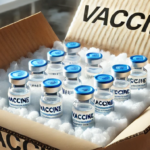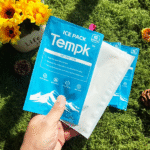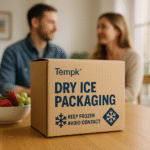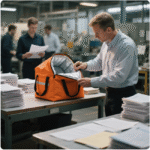Keeping medicines at the right temperature isn’t just a quality issue—it’s a matter of patient safety and compliance. Cold chain pharmaceutical transport refers to the entire process of storing, packaging and moving temperature-sensitive drugs, from manufacturing facilities to patients and clinics. في 2025 the global pharmaceutical cold chain market is valued at roughly دولار أمريكي 65 مليار and is projected to more than double to دولار أمريكي 137 مليار من قبل 2034. Some biologic therapies and vaccines lose their potency if exposed to temperatures outside the recommended range for even a few minutes. As demand for biologics and gene therapies grows, ensuring robust transport conditions becomes essential for maintaining efficacy and preventing costly waste.

What is cold chain pharmaceutical transport and why is it critical? We’ll demystify key concepts like temperature bands and the chain of custody while highlighting how proper handling preserves drug efficacy.
How does the market look in 2025 and what drives growth? We’ll discuss key statistics like market size, segments and growth drivers such as biologics, vaccines and AI-driven monitoring.
What are the primary temperature ranges and packaging solutions? Learn about controlled room temperature, مبردة, ultra low and cryogenic categories, and how technologies like phase-change materials support each.
Which regulations and good practices apply? We’ll break down Good Distribution Practices, GDP pillars, data integrity requirements and global regulations that govern distribution.
What are the latest trends for 2025? Explore innovations like AI and IoT monitoring, الاستدامة, advanced packaging and collaborative ecosystems.
How can you implement an effective cold chain strategy? Practical tips and checklists will help you plan training, contingency planning and continuous monitoring while reducing risk.
What is Cold Chain Pharmaceutical Transport and Why Does It Matter?
إجابة مباشرة: Cold chain pharmaceutical transport refers to the integrated processes and technologies used to maintain pharmaceutical products within a specified temperature range from manufacturing to administration. The goal is to preserve stability, safety and efficacy. Drugs such as vaccines, hormones, biologics and gene therapies are highly sensitive to temperature fluctuations; exposure outside 2 درجة مئوية إلى 8 °C or ultra low conditions can degrade active ingredients. Strict temperature control reduces waste, ensures patient safety and supports regulatory compliance.
Background and context: Traditional supply chains move bulk goods that can tolerate ambient conditions. Cold chain transport, لكن, deals with products that have narrow temperature windows. على سبيل المثال, mRNA vaccines require temperatures below − 90 °C while most biologics need 2 درجة مئوية إلى 8 درجة مئوية. Modern cold chain operations include precision cooling, العبوة المعزولة, refrigerated vehicles and IoT-enabled monitoring devices that collect real time data. Monitoring extends beyond temperature to include humidity, shock and light exposure, creating an unbroken chain of identity and custody from manufacture to administration. Maintaining this chain ensures that each dose delivered is traceable, validated and safe.
Understanding Temperature Categories and Their Impact
| نطاق درجة الحرارة | المنتجات النموذجية | Importance to You |
| Controlled Room (20 درجة مئوية – 25 درجة مئوية) | oral liquids, some tablets | Eliminates heat damage; simple packaging reduces cost |
| مبردة (2 درجة مئوية – 8 درجة مئوية) | معظم اللقاحات, الأجسام المضادة أحادية النسيلة | Avoids potency loss; built in temperature loggers help you verify compliance |
| Frozen/Ultra low (−20 °C – −80 °C) | RNA vaccines, البيولوجيا | Requires specialized freezers; temperature excursions can cause product failure |
| المبردة (< -150 درجة مئوية) | علاجات الخلايا, CAR T products | Cryogenic shippers using liquid nitrogen keep the product viable for days; critical for gene-modified therapies |
نصائح ونصيحة عملية
Match packaging to product needs: Choose packaging that aligns with temperature range. ل 2 درجة مئوية إلى 8 °C shipments, insulated shippers and gel packs may suffice. For cryogenic products, opt for liquid nitrogen–based dry vapor shippers validated to maintain below −150 °C for ten days.
Use continuous monitoring: Temperature loggers and GPS trackers provide real time alerts if conditions deviate. Many systems integrate humidity, shock and light sensors.
Implement clear chain of custody/identity: Label shipments with unique identifiers linked to patient or batch data to prevent mix ups and ensure compliance with regulations like DSCSA and EU GDP.
حالة العالم الحقيقي: A biopharmaceutical company shipping a monoclonal antibody from the U.S. to Europe improved product stability by switching to phase-change materials and data loggers. They reduced temperature excursions by 80%, leading to fewer reshipments and saving US$2 million annually.
How Does the Cold Chain Pharmaceutical Market Look in 2025?
إجابة مباشرة: The cold chain pharmaceutical logistics market continues to expand rapidly. في 2024 it was valued at US$59.97 billion, and by 2025 it is expected to reach US$65.14 billion وبمعدل نمو سنوي مركب (CAGR) ل 8.63% خلال 2034. North America holds the largest share due to high biologics consumption and strict regulations, while Asia Pacific is the fastest-growing region because of rising vaccine demand. Market drivers include the growth of biologics and gene therapies, increased vaccine deployment, and rising adoption of advanced monitoring technologies.
Expanded context: The market boom is propelled by more than new therapies. زيادة 85% of biologic drugs require refrigeration or freezing to maintain potency. معًا, ال COVID 19 pandemic raised public awareness of vaccine logistics, leading governments to invest heavily in cold chain infrastructure. In the U.S. وحيد, the pharmaceutical cold chain packaging market was valued at US$1.23 billion in 2024 and is projected to grow 14.6% annually between 2025 و 2030. This surge has attracted investors and technology companies focused on sensors, AI and sustainable materials.
Breakdown of Key Drivers and Segments
| Segment | 2025 Market Share | وصف & دلالة |
| مواصلات & الخدمات اللوجستية | ~48% | Includes road, air and sea freight; dominated by specialized carriers offering refrigerated trucks, refrigerated containers and cryogenic shipping. Ensures drugs arrive within required temperature windows. |
| التغليف | ~20% | Covers insulated boxes, phase-change material packs and smart containers. Innovation in sustainable materials and reuse is a major trend, particularly in packaging aimed at reducing environmental impact. |
| تخزين & التخزين | ~15% | Includes refrigerated warehouses, ultra low freezers and cryogenic storage facilities. Investments are increasing due to aging infrastructure and stricter environmental regulations. |
| يراقب & Software | ~17% | Real time data loggers, IoT platforms and predictive analytics help companies track and optimise shipments, reducing excursions and ensuring compliance. |
Real-World Implications
استثمر في التكنولوجيا: Adopting AI-driven routing and predictive analytics can reduce spoilage rates and lower operational costs.
Collaborate with specialists: Partner with logistics providers who understand local regulations and can manage cross-border shipments seamlessly.
Consider regional nuances: Infrastructure quality and regulations vary; tailor strategies for North America, Europe and Asia accordingly.
القضية الفعلية: Following an expansion into Asia, a U.S. pharma company partnered with a local cold chain specialist. The collaboration improved compliance with country-specific regulations and shortened delivery times, boosting sales by 15% within the first year.
What Are the Primary Temperature Bands and Packaging Solutions?
إجابة مباشرة: Pharmaceutical products fall into four main temperature categories: controlled room temperature, مبردة, frozen/ultra low and cryogenic. Packaging must maintain the required temperature range throughout transit while protecting products from physical shocks and environmental stress. مواد تغيير المرحلة (PCMS), حزم هلام, ألواح معزولة بالفراغ (كبار الشخصيات) and liquid nitrogen dry-vapor shippers are the most common solutions.
Additional details: Controlled room shipments use insulated boxes and PCMs to maintain 20 درجة مئوية – 25 درجة مئوية. Refrigerated shipments rely on gel packs or PCMs with high specific heat capacity. Ultra low shipments often use dry ice or PCMs that melt around − 40 درجة مئوية. Cryogenic shipments use liquid nitrogen–based dry-vapor shippers that keep product temperatures below − 150 °C for up to ten days. Packaging must be validated under ICH guidelines to prove it can hold the required temperature under worst-case conditions.
Packaging Technologies Demystified
| نوع التغليف | Working Mechanism | أفضل استخدام | Practical Advantages |
| حزم هلام | Water or gel-filled packs absorb heat; freeze and load into insulated shippers | Short-distance refrigerated (2 درجة مئوية -8 درجة مئوية) الشحنات | سهل الاستخدام; غير مكلف; متوفر على نطاق واسع |
| مواد تغيير المرحلة (بي سي إم) | Materials like paraffin wax or salt hydrate absorb/release heat at a constant temperature during phase transition | Controlled room (20 درجة مئوية – 25 درجة مئوية) or refrigerated shipments; sometimes ultra low | Provide precise temperature control; longer duration; reusable and eco friendly |
| الجليد الجاف & كبار الشخصيات | Solid CO₂ sublimates at −78.5 °C; vacuum-insulated panels reduce heat transfer | Frozen/ultra low shipments; vaccines needing −20 °C to −80 °C | Dry ice is widely used; VIPs enhance performance; caution due to CO₂ emission |
| Liquid Nitrogen Dry-Vapor Shippers | LN₂ evaporates inside absorbent walls to create a vapor environment below −150 °C | Cryogenic shipments (علاجات الخلايا, العلاجات الجينية) | Maintain temperature for >10 أيام; non-spill; قابل لإعادة الاستخدام |
نصائح ونصيحة عملية
Select packaging based on transit duration: For domestic shipments of a few hours, قد تكون عبوات الجل كافية; للشحنات الدولية, choose PCMs or VIPs for better performance.
Plan for requalification: Packaging must be requalified when there are changes in product, shipping lane or ambient conditions. Regular requalification ensures performance and compliance.
خيارات الصديقة للبيئة: Reusable PCMs and recyclable insulation reduce environmental impact and may lower overall cost.
القضية الفعلية: A European vaccine manufacturer replaced single-use foam packaging with reusable PCM containers. The company reduced packaging waste by 70%, saving €500,000 in disposal costs in the first year.
Which Regulations and Good Practices Govern Cold Chain Pharmaceutical Transport?
إجابة مباشرة: The pharmaceutical cold chain is governed by ممارسات التوزيع الجيدة (الناتج المحلي الإجمالي), ممارسات التصنيع الجيدة (ممارسات التصنيع الجيدة) and various regional regulations such as the U.S. Drug Supply Chain Security Act (DSCSA), European GDP Guidelines, WHO guidelines and local laws. GDP covers quality systems, personnel training, premises, معدات, العمليات, الوثائق, complaint handling, self-inspection and traceability. Compliance ensures product integrity, prevents counterfeiting and maintains public trust.
Expanded context: The Lascar Electronics compliance guide emphasises that effective cold chain management requires accurate temperature maintenance, 24/7 يراقب, البنية التحتية المعتمدة, secure storage, specialist packaging, detailed record keeping, contingency planning and trained staff. It also points to regulatory frameworks such as EU GDP, NIST calibration, EU GMP Annex 11 and EU Clinical Trials Regulation. Noncompliance can result in product recalls, financial loss and harm to patients.
Key Compliance Pillars
نظام الجودة & التوثيق: Establish SOPs and maintain audit trails. Every step must be documented from temperature logs to chain-of-custody records.
Trained Personnel: Staff must understand handling procedures, packaging preparation and emergency protocols.
Premises & تخزين: Facilities must be validated for temperature control, have backup power and alarm systems, and be secure from tampering.
معدات & المركبات: Use calibrated refrigerators, المجمدات, insulated trucks and sensors; ensure equipment is regularly maintained
Operations & Risk Management: Implement risk assessments, contingency plans and supply chain mapping to handle delays, customs holds or equipment failure.
إمكانية التتبع & Product Identification: Implement serialisation and barcoding to track individual units and integrate with DSCSA or EU FMD systems.
نصائح ونصيحة عملية
استثمر في التدريب: Conduct regular training and competency assessments; include updates on regulatory changes.
Audit suppliers: Evaluate packaging vendors, carriers and warehouses to ensure they meet GDP and GMP requirements.
Prepare contingency plans: Identify backup carriers, alternative transport routes and inventory strategies to mitigate disruptions.
Implement data integrity measures: Use validated digital systems with secure access, regular backups and audit trails to ensure data accuracy and compliance with Annex 11.
مثال على ذلك: أثناء انقطاع التيار الكهربائي, a logistics company’s backup generators failed. Because they had contingency plans and validated packaging, the vaccines remained within required temperatures for 36 ساعات, avoiding product loss and regulatory penalties.
What Are the Latest Trends and Technological Advances in 2025?
إجابة مباشرة: ال 2025 landscape features digital transformation, عبوة مستدامة, collaboration, regulatory evolution و new therapeutic products. الذكاء الاصطناعي (منظمة العفو الدولية) وإنترنت الأشياء (إنترنت الأشياء) أجهزة استشعار enable real-time monitoring, predictive analytics and proactive risk management. Sustainability is a key trend; companies invest in reusable packaging and materials that minimise environmental impact. Partnerships between logistics providers, manufacturers and technology firms help navigate complex regulations and ensure continuity.
نظرة عامة على الاتجاه: The cold chain market is evolving toward a proactive, data-driven model. Companies deploy software platforms that provide full visibility into shipments, integrate with enterprise resource planning (ERP) and allow predictive maintenance. Environmental concerns are driving adoption of reusable containers, phase-change materials and renewable energy in warehouses. Regulatory frameworks are becoming more stringent, with the U.S. discussing the Biosecure Act, which may restrict supply chain partners from certain regions. The number of temperature-sensitive products is rising, particularly cell and gene therapies, requiring cryogenic transportation.
أحدث التطورات في لمحة
التحليلات التنبؤية & منظمة العفو الدولية: AI-powered platforms evaluate weather, traffic and historical data to predict delays and proactively reroute shipments, تقليل التلف.
Digital Twins: Digital replicas of supply chains simulate processes and identify vulnerabilities before physical shipments occur.
Blockchain للتتبع: Blockchain technology provides immutable records of product provenance, increasing trust in supply chains.
مواد مستدامة: حاويات قابلة لإعادة الاستخدام, biodegradable insulation and PCMs reduce waste; companies implement circular logistics programmes for packaging return.
Collaborative Ecosystems: Logistics providers partner to share hubs, combine shipments and leverage each other’s strengths.
رؤى السوق
The global cold chain logistics market across industries was valued at US$293.6 billion in 2023 ومن المتوقع أن يصل US$862.3 billion by 2032, ينمو عند أ 13% CAGR. Pharmaceuticals remain a major driver of this growth. Companies invest in upgrading facilities and adopting digital tools to meet growing demand. Geopolitical influences, like supply chain disruptions and tariffs, continue to affect transit times and capacity. The trend toward bigger distribution facilities closer to patients is emerging as companies aim to shorten last-mile delivery times and reduce temperature excursions.
مثال الحالة: A major European logistics provider implemented an AI-driven predictive platform. في غضون ستة أشهر, they cut temperature excursions by 40%, reduced fuel consumption by 15% and improved on-time delivery by 20%. The success led them to roll out the system globally.
الأسئلة الشائعة (التعليمات)
What happens if a vaccine isn’t kept cold? Exposing vaccines to incorrect temperatures can degrade active ingredients, causing them to lose potency. This may lead to ineffective immunisation and wasted doses. Always monitor temperature and use validated packaging.
Is dry ice still relevant for vaccine shipping? نعم. Dry ice remains a common refrigerant for frozen and ultra low shipments (− 20 °C to − 80 درجة مئوية). لكن, phase-change materials and vacuum-insulated panels are increasingly used for improved performance and sustainability.
Do all biologics require refrigeration? Most biologics require cold chain conditions. تقريبًا 85% of biologic drugs need refrigeration or freezing to maintain stability, but always check the manufacturer’s storage guidelines.
What is the difference between chain of custody and chain of identity? ال سلسلة الحضانة records who handled the product, what actions were performed, when and where. Chain of identity links the product with the correct patient or batch, ensuring no mix ups. Both are essential for regulatory compliance.
How can small companies comply with GDP? Start by developing SOPs, training staff, selecting qualified logistics partners and investing in simple monitoring devices. Regular audits and continuous improvement will strengthen compliance over time.
ملخص وتوصيات
Ensuring safe cold chain pharmaceutical transport is critical for patient safety, regulatory compliance and business success. بواسطة 2025 the market is growing rapidly due to biologics and new therapies requiring stringent temperature control. Achieving success involves understanding temperature bands, choosing appropriate packaging, complying with GDP and other regulations, adopting advanced monitoring technologies and aligning with the latest trends in sustainability and digitalisation. Continuous monitoring and proactive risk management help protect products from damage and reduce waste.
الخطوات التالية القابلة للتنفيذ:
Assess your portfolio: Determine the temperature requirements of each product and evaluate current transport procedures.
Select or upgrade packaging: Choose validated shippers (حزم هلام, PCMS, الثلج الجاف, LN₂) that match product needs and shipping routes.
تنفيذ المراقبة: Deploy IoT sensors and predictive analytics to gain real time visibility and maintain chain of custody/identity.
Train and audit: Invest in regular staff training and supplier audits to ensure compliance with GDP and local regulations.
خطة للاستدامة: Explore reusable packaging and circular logistics to reduce environmental impact and meet corporate sustainability goals.
حول Tempk
Tempk is a global leader in cold chain solutions with decades of experience delivering vaccines, biologics and advanced therapies worldwide. Our expertise spans refrigerated and cryogenic transport, validated packaging solutions and real time monitoring platforms. We provide end-to-end services from route planning and packaging design to on-time delivery and compliance support. Our mission is to ensure medicines arrive potent and safe while reducing waste and improving patient outcomes.
على استعداد لتحسين سلسلة التبريد الخاصة بك? Contact Tempk for personalised advice and discover how our solutions can ensure reliable pharmaceutical transport in 2025 وما وراءها.























